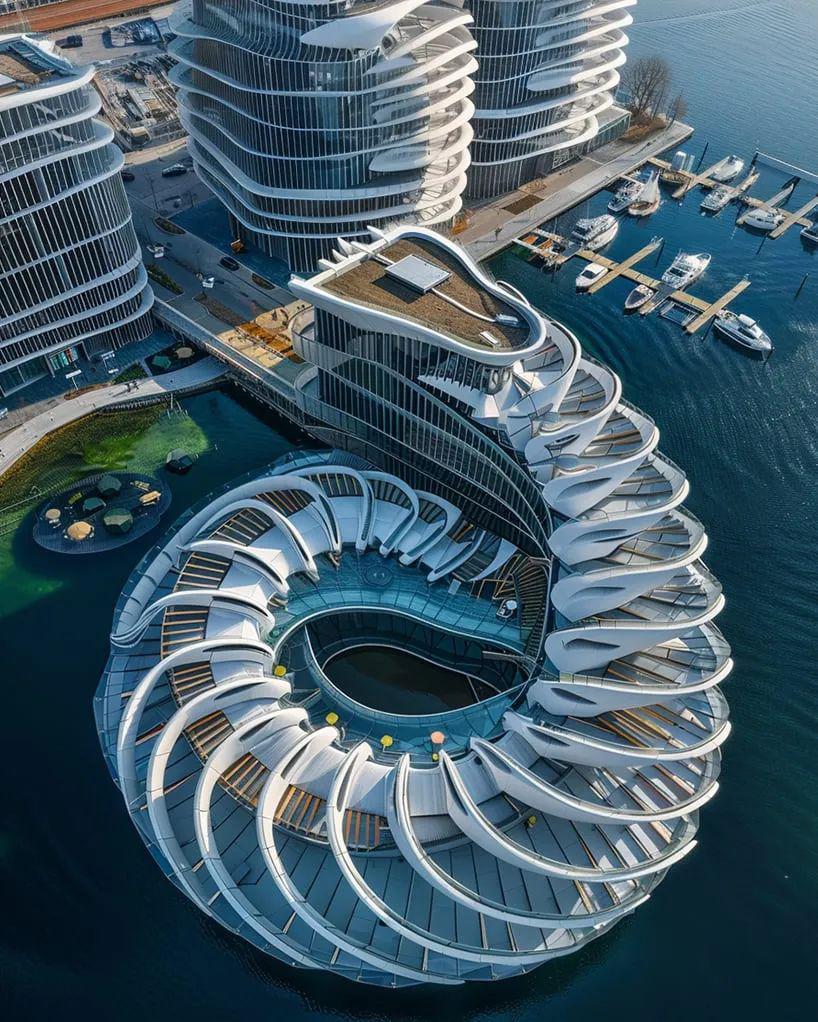来源:搜建筑
马纳斯-巴蒂亚的未来螺旋状建筑 MANAS BHATIA’S NAUTILUS BIOARCHITECTURE FOR THE FUTURE 利用黄金比例的永恒之美,Manas Bhatia构想了一个未来主义的城市景观,在那里,漂浮的摩天大楼就像鹦鹉螺壳一样展开。鹦鹉螺生物建筑系列的结构由 Midjourney、LookX 和 ChatGPT 等 人工智能工具 进行可视化,被景观花园和露台环绕,在广阔无垠的海洋中营造出一片绿洲。它们错综复杂的螺旋图案受斐波那契数列的支配,通过优化空间布局和增强结构稳定性,体现出超越单纯功能的和谐感和比例感。对于建筑师来说,重要的是要回顾过去,数学与建筑的结合产生了人类历史上一些最具标志性和经久不衰的作品,从而为未来的建筑塑造一个更加和谐和可持续发展的建筑环境。

MANAS BHATIA’S NAUTILUS BIOARCHITECTURE FOR THE FUTURE
Harnessing the timeless beauty of the golden ratio, Manas Bhatia envisions a futuristic cityscape where floating skyscrapers unravel like Nautilus shells. The structures of the Nautilus Bioarchitecture series, visualised by AI tools including Midjourney, LookX, and ChatGPT, are enveloped with landscaped gardens and terraces, creating a verdant oasis amidst the vast expanse of the ocean. Their intricate spiral patterns, governed by the Fibonacci sequence, hold a sense of harmony and proportion that transcend mere functionality with optimized spatial layouts and enhanced structural stability. For the architect, it is important to look to the past, where the marriage of mathematics and architecture has yielded some of the most iconic and enduring creations in human history, to shape the architecture of tomorrow with a more harmonious and sustainable built environment.

FLOATING CITYSCAPE BASED ON HISTORIC MATHEMATIC PRINCIPLES
Embedded within the fabric of our universe, the golden ratio has long served as a guiding principle in both architecture and nature. Dating back to ancient civilizations, this mathematical ratio, approximately 1.618, has been revered for its ability to create compositions of sublime beauty and proportion. From the Parthenon in Athens to the pyramids of Giza, examples of the golden ratio abound in architectural masterpieces throughout history.



But its influence extends far beyond the realm of human construction, permeating the natural world in the spiral patterns of Nautilus shells, the branching of trees, and the proportions of the human body. Recognizing this inherent harmony between mathematics and aesthetics, Indian architect Manas Bhatia, among his contemporaries, seeks to integrate these principles to realize buildings that resonate with the rhythms of nature. ‘Could we create buildings that mimic the resilience and adaptability of these natural forms?’ he questions. It is a question that resonates deeply in today’s world, where concerns about climate change and urbanization loom large. Bioarchitecture offers a glimpse into a more sustainable future. ‘By harnessing the power of nature-inspired design, we can build cities that are not just beautiful, but also resilient and adaptable,’ says Bhatia.


FUSING MATHEMATICS AND ARCHITECTURE USING AI
Beyond aesthetic appeal, the application of these principles provide architects with a versatile toolkit to create buildings and environments that foster a sense of balance and well-being for their inhabitants, from optimizing spatial layouts to enhancing structural stability and efficiency. The interpretation and application, however, can be subjective. While some architects may choose to incorporate these principles explicitly into their designs, others may prefer to draw inspiration from a broader range of sources, including cultural influences, historical contexts, and personal creativity.



The advent of computational design and AI tools is revolutionizing the architectural process, allowing architects to explore complex geometries and intricate forms with unprecedented precision and efficiency. While these tools can certainly facilitate the integration of mathematical ratios into architectural design, they also offer architects a greater degree of freedom and flexibility to experiment with diverse design approaches. ‘Ever wondered why we don’t use sacred geometry in architecture, despite nature following its principles? How can we achieve that oneness with nature?’ Manas Bhatia questions. While the golden ratio and Fibonacci sequence can undoubtedly enhance the aesthetic appeal of a structure, architects must also consider factors such as building codes, client preferences, budget constraints, and technological advancements. In many cases, these practical considerations take precedence over purely mathematical principles.




